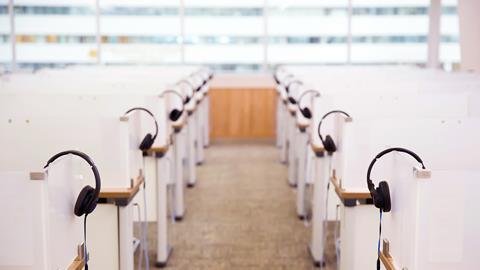What are the obstacles that call centres in the insurance industry face in transitioning to working from home and what are some firms that have done this successfully doing right? Insurance Times find out
Many call centres are not technologically ready to work remotely after all non-essential businesses were ordered to work from home following the government’s lock down orders back in March.
Moving all call centre staff to remote working is no easy task, and if businesses do not get this transition right, some could face closure as they grapple with the high call volumes, and the pressure of dealing with claims under special working arrangements.
Although some call centres will weather the storm, others won’t be as lucky.
Insurance Times takes a look at the challenges facing these call centre businesses, and how they are being overcome.
Workable on paper
Paul Stanley, chief executive at 360Globalnet, warned that the insurance industry would need to have flexible IT claims systems in place that are quickly configurable to fit the new ways of working, otherwise whole systems may become unusable.
“The insurance industry now has to consider the worst potential impacts of Covid-19 and we are gearing up to respond to cases where whole claims systems may become unusable as a result of office closures,” he says.
The worry is that, although many disaster plans feature the backing up of existing systems to alternative sites, the lock down conditions implemented by the government means that even these sites are unavailable, and alternative remote systems need to be explored.
360Globalnet have created an online response to CAT events within short time periods and are gearing up for more requests if the situation worsens – for example video streaming could be used if a loss adjuster cannot visit the site of a claim.
Meanwhile, James Crask, consulting director and resilience advisory lead at Marsh Risk Consulting added that working from home was workable on paper, but hard to implement due to the level of IT stress testing that needs to be done first.
The new normal
Law firm Slater & Gordon were one of the firms that were technologically prepared, and chief information officer Jon Grainger told Insurance Times that it was already well on its way with its “Work Anywhere strategy” prior to the lock down being implemented.
“Normal customer channels have been able to be maintained, with the exception of face-to-face consultation, which we are replacing with video consultation,” he said.”Effectively you have some backbone technology that needs to be in place before the event, and then it’s a case of accelerating it. So, the timing for us is very fortuitous.”
Using Microsoft Teams and Office 365 the law firm has enabled its employees to decouple their location and work anywhere using different channels such as messaging and video calls.
However, when Grainger put the “Work Anywhere strategy” together he couldn’t have predicted that it would be implemented in this way.
This “new normal” of working from home, he says, is also about managing time effectively. It has also implemented digital signatures and document managing, as well as putting measures in place to spot technology that needs fixing.
“I think there’s an anxiety that builds when you can’t physically see everyone,” Grainger said. ”We’re not saying that it is better than face-to-face, what we are saying is that it is equivalent to how we have been serving customers.
“We want to get through Covid-19 and make sure that we continue to provide consumer legal services to everyone in the UK. For all of us, with this new working from home, we have just got to make sure that we are in for a marathon and not a sprint.”
For call centres to be able to function from home, Grainger added there must be telephony already in place and configured, as well as enough technology for staff, such as laptops.
Seamless transition
Saga also had a seamless transition to remote working, with chief executive Cheryl Agius telling Insurance Times that it has over 2,300 staff that are home enabled, and out of this figure around 1,000 employees uphold its call centres.
Like Slater & Gordon, Saga already had some technological solutions like flexible telephony and IT systems in place – at the start of the year it had around 150-200 customer facing agents working from home.
Starting this initiative in 2019, meant that when the lock down hit it was a natural continuation to scale up.
“We have had a very adaptable front line – the managers have been tremendous,” Agius said. “They managed 150-200 at the start and they are now managing a significant number of people remotely”
Saga’s call centres have had call answer rates of 97%, with 80% of its customers getting answered in 20 seconds.
”I’m very proud of them all. The impact has been no interruption for our customers. It’s a moment of crisis that brings you all together,” she said.
Challenges
Speaking about common problems that call centres might experience, Agius said that the severity of these issues would depend on whether businesses had planned for interruption and relocation to another office, but she believes that every business would have struggled in adapting to the pace that the pandemic has unfolded.
“They may not have had the telephony and the IT capability to be able to switch that on at home and be able to monitor that productivity,” she said. “That’s a very different beast to have all your phone lines enabled to work from home. I expect they [the insurers] had back up plans and outsourced arrangements, but if you have everyone calling on those outsourced arrangements then the demand far exceeds the supply.”
Agius also highlighted the issue of enabling these solutions in such a short space of time, but said that these issues would not be unique to the insurance industry.
Outlook
In terms of the future, Agius said: “I believe in silver linings in all of this, I think that businesses will have tested their continuity measures to the extreme and be ready for a pandemic looking at those catastrophic risks in a different light.”
She believes that there will be many positives to be drawn from this and predicted that customer retention rates might improve as a result of the pandemic, as customers will not have the freedom to shop around as usual.
She also added that office life will never look the same again.
Grainger agreed, adding: “A new normal will appear, there is still a positive response with flexibility, being connected and being able to work from home, I think its going to prove you can work anywhere. I think it will make in-person meetings more special.”
Read more…Working from home hard to implement for some businesses during Covid-19
Not subscribed? Become a subscriber and access our premium content

Hosted by comedian and actor Tom Allen, 34 Gold, 23 Silver and 22 Bronze awards were handed out across an amazing 34 categories recognising brilliance and innovation right across the breadth of UK general insurance.




















































No comments yet